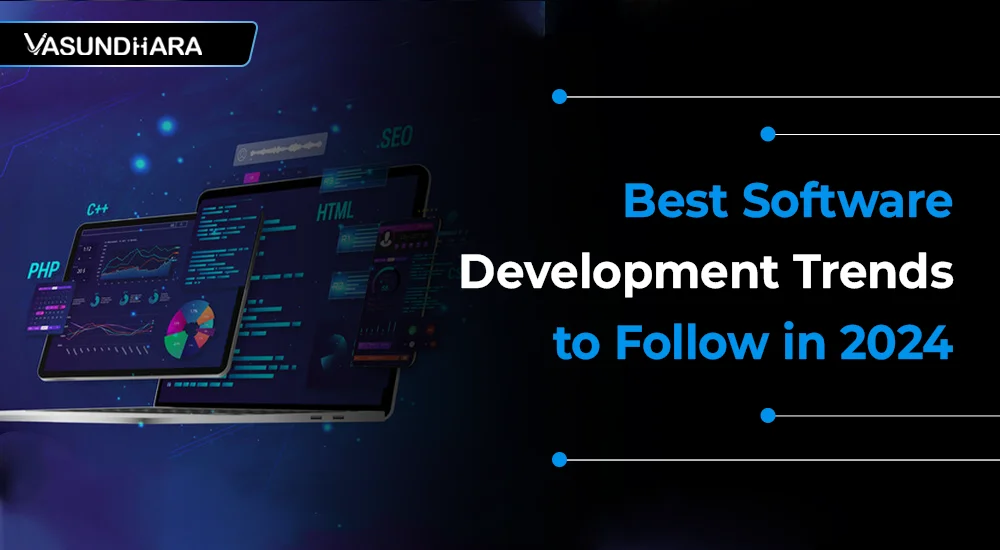Best Software Development Trends to Follow in 2024


- Jun 6, 2024
The growth of software development in 2024 is ongoing and will persist in the months ahead. We would presumably observe many developments driven by technological and societal needs.
For instance, blockchain is propelled to the next level by the necessity of a secure method of contract execution, while emergent AI applications necessitate a greater emphasis on "ethical AI" practices. The industry will continue to evolve as a result of the increased use of VR and AR applications.
Many organizations are implementing digital acceleration, and custom software development services from companies will assist them in devising innovative strategies to advance their operations in a manner that benefits society, consumers, and their bottom lines. Consider hiring the best software development company for your custom software development needs.
The comprehensive guide will explore the top 12 software development trends in 2024 to facilitate substantial industry transformations.
Before we delve into the software development trends, it is important to examine a few key statistics that underscore the global software market's significant growth and potential:
The growing dependence of all industries on technology is reflected in the projection that global IT investment will reach $5.1 trillion in 2024.
The global software industry is expected to grow at a compound annual growth rate (CAGR) of 11.74% to reach around USD 1,789.14 billion by 2032, from the anticipated USD 589.6 billion in 2022.
The software development market is anticipated to reach $1039 million by 2027, with a compound annual growth rate (CAGR) of 22.54% from 2020 to 2027.
JavaScript is the most frequently employed programming language on a global scale. Approximately 65.82% of software developers favor its utilization.
It's important to stay current about the latest developments in software development in 2024, and it's also critical to rapidly adjust to new technologies and approaches.
Therefore, it's critical to stay current on industry developments to remain competitive and make wise decisions for your nearshore software development projects. Custom software can solve your business challenges by providing tailored solutions that address specific needs, streamline operations, enhance productivity, and offer a competitive edge by leveraging unique features and integrations that off-the-shelf software cannot provide.
In today's ever-changing tech world, we've compiled a list of 15 software trends essential to your projects' success.
Let's now examine each trend in more detail:
In 2023, Cloud was adopted by governmental organizations and institutions, in addition to entrepreneurs and businesses. Legal authorities, hospitals, security offices, and the Pentagon acknowledge the value of technology. By the conclusion of 2024, it is feasible that there will be a substantial migration of enterprises and institutions to the Cloud, not only in the United States but also globally.
This computing form has never been simpler to transition to, which is why Cloud computing is one of the most prominent software industry trends. Currently, all global firms are investing in the technology, with Google, Amazon, and Microsoft being the frontrunners. This technology enables cloud computing for both enterprises and individuals. Additionally, you may obtain complimentary credits for the initial month to determine whether the Cloud infrastructure suits your requirements.
Due to recent advancements in container development and cloud computing, more developers are now considering microservices as a dominant form of architecture. A long time ago, monolithic architecture, which involves the construction of a single, large service and adding new features as the project expands, was demonstrated to be not very scalable. However, the potential for microservices to reach their zenith is only now becoming a reality due to the numerous advancements in cloud computing.
Instead of constructing a single exceptional service, developers will partition the functionality into small, manageable components. The software will be composed of microservices, each executing a singular function with precision. If you require an update to a function, modify a single microservice.
Also read: The Type of Software Development Solutions by Vasundhara Infotech
Python is a language compatible with all contemporary development requirements. It can manage a variety of projects, including enterprise projects, mobile development, and web development. Python's capacity to facilitate the execution of intricate mathematical operations, data analysis, machine learning, and neural network construction distinguishes it from other universal languages.
Python is currently ranked third in prevalence, following Java and C. Its demand has increased by twofold, indicating an extraordinary growth rate. Additionally, Python is not overly challenging to learn but can be customized to accommodate advanced skill levels and complex undertakings.
In recent years, numerous discussions have concerned the selection of native versus hybrid development. Developers were initially drawn to hybrid development due to its cost-effectiveness and simplicity. Applications are anticipated to be cross-platform, and it is more cost-effective to employ a single team rather than multiple.
Nevertheless, enterprises recognized that disregarding the standards of native development is not always the most effective approach to creating an intuitive and complex solution. Although entrepreneurs and small businesses are likely to continue pursuing hybrid development at a lower cost, enterprises will likely return to more dependable native practices.
Business proprietors are granted enhanced cost efficiency and adaptability through outsourcing software development. Instead of hiring new in-house developers and paying them on a regular basis, managers can partner with a remote provider and pay the team on an hourly or per-project basis if in-house teams lack the necessary skills in certain tech frameworks. Consider hiring offshore software development company for your custom software development project.
The expanding software development markets in Eastern Europe, particularly Ukraine, generate powerful competition for Western colleagues. Developers possess comparable levels of expertise, albeit at substantially reduced rates, due to disparities in local prices relative to those in the United States. Their involvement with numerous industries and layers significantly enhances their understanding of potential solutions.
Artificial Intelligence has been the most prominent technology trend for numerous years, and this trend is unlikely to change in 2024. In the previous year, both large corporations and smaller ventures continued to invest in AI. Users become more acclimated to utilizing AI for daily activities each year, and it does not initiate as many ethical discussions.
Incorporating AI into solutions becomes a necessity for developers rather than a preferable practice. TensorFlow, a library for neural network development, was developed by Google to recognize this trend. It offers developers a rapid environment for constructing and testing neural networks when combined with Theano, one of the most prominent AI frameworks.
The 5G network has been in development for an extended period of time; however, communications professionals are confident that it will be released this year and become one of the most significant IT trends of 2024. The connection capability will be significantly enhanced for developers, and users will be able to receive online offers from all over the globe. It also refers to the enhanced speed of mobile connections, which is a critical criterion for the integration of intricate innovations such as augmented reality or machine learning into mobile applications.
5G will offer new opportunities for mobile gaming and significantly enhance the speed and accessibility of communications. Developers will have the opportunity to integrate the most advanced technologies into mainstream solutions and conduct more experiments with new applications.
We have previously discussed the fact that cloud computing will continue to flourish in 2024. Nevertheless, it is not the sole computational innovation of the year. Cloud computing is no longer an option when software necessitates real-time data processing in the presence of low-quality bandwidth. The application will be unable to access remote data centers as soon as an Internet connection is lost.
By moving data to the periphery of the local network, edge computing enables users to utilize the software both online and offline, thereby resolving this issue. The edge will be the predominant computational form in industries where a blackout could result in substantial losses, such as transportation and healthcare.
According to statistics, the demand for peripheral computing is expected to increase by 28 times between 2018 and 2025. Some of this has already occurred; however, the future is replete with numerous opportunities for peripheral networks.
The demand for software development is consistently on the rise. Even industries that are not inherently digital, such as agriculture, are experiencing accelerated digital transformation. Although the employment of a software development team is not a top-priority expense for many business owners, they still recognize the necessity of digital solutions.
Also read: Low-Code vs. No-Code Development: What's the Difference?
Software development can be simplified through the use of responsive graphical interfaces, much like how design was simplified by tools such as Canva and PicMonkey. No-code development has been a popular trend in web development for some time, as evidenced by services such as Wix. This trend is expected to expand to other software development sectors in 2024.
Ready to Get Started with Custom Software Development? Get in touch with our expert team at Vasundhara Infotech, a leading healthcare software development company.
DevOps has been transforming software development methodologies for an extended period of time. The integrated approach to development and testing facilitates the creation of products of superior quality and unites teams in pursuit of a shared objective. Developers and evaluators can commence the development of the product following best practices from the very beginning stages by sharing responsibility, thereby avoiding the need to rebuild the functionality.
Nevertheless, the conventional DevOps system frequently lacked a critical component. The final solution was left vulnerable to cyber threats, as testing did not always encompass the essential security practices. DevSecOps is a development model that can resolve this issue and prioritize security within the development endeavor.
DevSecOps is a novel approach to integrating security practices into the development process. Security teams do not participate in projects at a later stage; rather, they are involved in the early phases to assist developers and testers in optimizing the safety of their operations from the outset.
Using machine learning, businesses, and organizations can anticipate events by examining their historical data. Data science algorithms gather insights into past events, organize them, identify patterns and logical relationships, and identify the most frequent trends. Machine learning can predict future events and establish the conditions that will result in them. By utilizing this information, business proprietors can avert the occurrence of these patterns.
Predictive analytics generates a number of additional fields, such as predictive maintenance. This form of maintenance is predicated on the continuous analysis of data. The software evaluates the equipment's current and historical condition and anticipates its impending failure. This information is transmitted to the maintenance team, which can address the issue before the occurrence of any possible outage.
Even though enterprises will cease to prioritize the widespread implementation of hybrid solutions, entrepreneurs and small businesses will continue to favor universal cross-platform development. For years, React Native has been a prominent software development trend, and it is unlikely that this will change.
Although Xamarin and Flutter, two of the most popular hybrid frameworks, provide a reasonable level of competition, React Native remains more user-friendly and offers a higher percentage of code reusability.
Many businesses will encounter challenges in 2024 as they attempt to adjust to security trends. To adapt to technological advancements, it is imperative to have a robust team with capabilities that surpass those of your internal technology platforms.
Vasundhara Infotech provides internationally recognized software development and testing services. Our team consistently remains informed about the most recent developments in software development trends. We are prepared to evaluate your business requirements and the current status of your digital transformation, identify the primary obstacles, and resolve them through disruptive solutions. We ensure that our technology is compatible with your requirements by considering tangible business outcomes.
Please do not hesitate to reach out to our team if you have an idea for a new or existing initiative. We will analyze your business model, market, and audience to determine the most suitable technology platform for your target audience.
Copyright © 2025 Vasundhara Infotech. All Rights Reserved.
